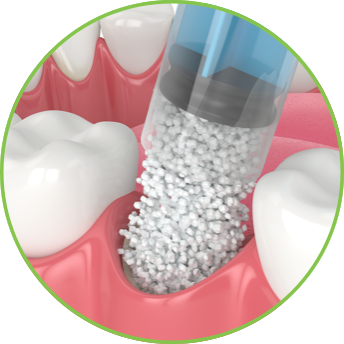
Periodontal disease is an inflammation of the gums that, if severe, can lead to the loss of the tissues that hold your teeth in place. If left untreated, periodontal disease can damage the tissues that support your teeth, even the bone. There are various stages to periodontal disease—from gingivitis (early stage) to periodontitis (advanced disease). Red and swollen gums that bleed easily are a sign of gingivitis. At this early stage, the disease may be reversed with a professional cleaning and more regular daily care at home. If you’ve developed gum disease severe enough to require surgery, we may discuss some of these types of gum surgery as ways to treat the problem: Crown Lengthening, Regeneration, Pocket Reduction, and Soft Tissue Graft
Crown Lengthening
In this procedure, we remove an overgrowth of gum tissue from your teeth, making your teeth appear longer. This procedure is used for cosmetic effects as well as to treat gum disease.
Regeneration
In this procedure, we fold back the gums and removes disease-causing bacteria, then inserts bone grafts, membranes, or tissue-stimulating proteins (or any combination of the three) to encourage your gum tissues to regenerate and fit snugly around the teeth again.
Pocket reduction (also known as gingival flap surgery)
In this procedure, we fold back the gums and removes bacteria. The dentist secures the gum tissue against your teeth, rather than allowing it to grow back on its own.
Soft Tissue Graft
In this procedure, we take sample tissue from elsewhere in your mouth and attaches it to your gums to replace gum tissue that has receded or has been removed due to gum disease.

A dental bone graft is a procedure performed to increase the amount of bone in a part of the jaw where bone has been lost or where additional support is needed. Bone may be taken from elsewhere in the body and surgically fused to existing bone in the jaw. Sometimes, cadaver material is used. A dental bone graft is sometimes needed if further procedures, such as dental implants, are necessary or if bone loss is affecting the health of nearby gums and teeth. Read on to learn how dental bone grafts work, how the procedure is done, and what results you can expect from this procedure. Dental bone grafts are done to help prevent long-term health problems associated with tooth loss and gum disease as well as to provide sufficient bone material to support dental implants. This common procedure is usually safe and well tolerated, though there are risks of side effects and complications. Following your doctor’s guidance during recovery will help minimize your chances of having problems after the procedure and improve the odds of maintaining good dental health in the years ahead.